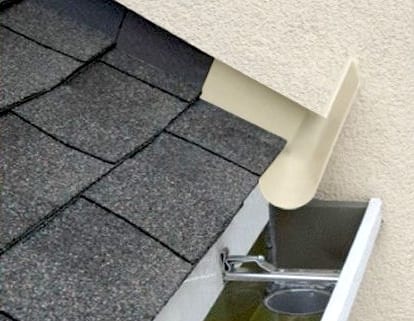Kickout Flashing
Kickout flashing, also known as diverter flashing, is a special type of flashing that diverts rainwater away from the cladding and into the gutter. When installed properly, they provide excellent protection against the penetration of water into the building envelope. 

Several factors can lead to rainwater intrusion, but a missing kickout flashing, in particular, often results in concentrated areas of water accumulation and potentially severe damage to exterior walls. InterNACHI inspectors should make sure that kickouts are present where they are needed and that they are installed correctly. Water penetration into the cladding can occasionally be observed on the exterior wall in the form of vertical water stains, although inspectors should not rely on visual identification. There may be severe damage with little or no visible evidence.
Inspectors may observe the following problems associated with kickout flashing:
The kickout was never installed.
- The need for kickout flashing developed fairly recently and the builder may not have been aware that one was required. The increased amount of insulation and building wrap that is used in modern construction makes buildings less breathable and more likely to sustain water damage. Kickout flashing prevents rainwater from being absorbed into the wall and is more essential than ever.
The following are locations where kickout flashing is critical:
- anywhere a roof and exterior wall intersect, where the wall continues past the lower roof-edge and gutter. If a kickout flashing is absent in this location, large amounts of water may miss the gutter, penetrate the siding, and become trapped inside the wall; and
- where gutters terminate at the side of a chimney.
The kickout was improperly installed.
- The bottom seam of the flashing must be watertight. If it is not, water will leak through the seam and may penetrate the cladding.
- The angle of the diverter should never be less than 110 degrees.
The kick-out was modified by the homeowner.
- Homeowners who do not understand the importance of kickouts may choose to alter them because they are unsightly. A common way this is done is to shorten their height to less than the standard six inches (although some manufacturers permit four inches), which will greatly reduce their effectiveness. Kickout flashings should be the same height as the side wall flashings.
- Homeowners may also make kickout flashings less conspicuous by cutting them flush with the wall.
In summary, kickout flashing should be present and properly installed in order to direct rainwater away from the cladding.




Leave a Reply
Want to join the discussion?Feel free to contribute!